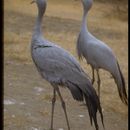Biology
(
Inglês
)
fornecido por Arkive
This crane feeds mainly on the seeds of grasses and sedges, waste grains, insects and a range of small vertebrates (8). Unlike other species of crane that probe the ground with their bills, the blue crane tends to take above-ground resources (6).
Courtship involves a 'dance' in which the male chases the female, interrupted with leaps, bows and bouts of calling (6). Nesting occurs during summer, usually from September to February, and the typical nesting site is secluded grassland at high elevations. The eggs are laid in the grass or on bare ground (8). Nesting occasionally occurs in wetlands, in which case a platform nest of reeds is constructed (8). Two eggs are usually produced per clutch, and these are incubated for 30 to 33 days. The young become fully fledged after 3-5 months (8).
Blue cranes undertake local migrations, moving to lower elevations in autumn and winter with their chicks. Flocking is known to occur throughout the year but is more common during the winter when large flocks of several hundred birds form (8).
Conservation
(
Inglês
)
fornecido por Arkive
As the population of the blue crane has plummeted, conservation action has increased (2). Measures taken to date include tighter legal protection for the species; research into the bird's ecology, biology and conservation status; surveys of the population; better habitat management on private land and the development of education programmes (7). Although the species occurs in 75 nature reserves in South Africa, just 200 breeding pairs are found in protected areas (8). There are a number of blue cranes in captive breeding facilities, but as yet, a reintroduction scheme to parts of the historic range has not been attempted (8). Providing that the species is well protected and that suitable habitat is restored, the wild population should be able to recover to an extent (8).
Description
(
Inglês
)
fornecido por Arkive
The elegant blue crane is the national bird of South Africa (6). As the common name suggests, it is pale blue in colour, although it can appear grey from a distance (2). It is a relatively small crane with a large head, thick neck and beautiful elongated wing feathers, known as tertials that trail behind this bird and are often mistaken for tail feathers (6). Most cranes have red patches of skin on their heads that are used in display. The blue crane does not have these bare patches, but instead has head feathers that can be erected when excited or during aggressive encounters (6). This species produces loud honking calls typical of cranes (2).
Habitat
(
Inglês
)
fornecido por Arkive
This crane breeds in dry grasslands at high elevations where there is less disturbance (6) (7). They may roost and breed in wetlands if available (7) and some individuals prefer to nest in arable and pastureland (2). In autumn and winter they usually move to lower altitudes (7).
Range
(
Inglês
)
fornecido por Arkive
The blue crane has the most restricted distribution of the 15 crane species (7). They are endemic to southern Africa, with 99% of the population occurring in South Africa (8). There are also small and declining breeding populations in northern Namibia (comprising of about 60 birds) and western Swaziland (just 12 birds) (2). This crane occurs as an occasional vagrant in northwestern Cape Province, northern Transvaal, Lesotho and Botswana (8). As recently as 1980, this species was considered to be healthy and not threatened (8). However, In South Africa, the population has declined by 50% since the 1970s (2). Recent estimates put the population at 21,000 birds, but 60-70% of these are non-breeding individuals (2).
Status
(
Inglês
)
fornecido por Arkive
Classified as Vulnerable (VU A1acde+2bcde) by the IUCN Red List 2003 (1). Listed under Appendix II of CITES (3), Appendix II of the African-Eurasian Migratory Water Bird Agreement (AEWA) (4) and Appendix II of the Convention on Migratory Species (CMS) (5).
Threats
(
Inglês
)
fornecido por Arkive
The main factor responsible for the drastic decline of this crane since the 1970s is deliberate and accidental poisoning (2). Cranes are illegally poisoned where they are perceived as crop pests, and they may be indirectly affected by poison aimed at other species causing crop damage (8). The other major threat is the planting of large areas of suitable grassland habitat with trees for commercial plantations (2). As well as removing suitable habitat, this can result in wetlands drying out as run-off and groundwater flow is affected (8). Other threats include collisions with power lines, predation by dogs, and the illegal capture of chicks for food and for the pet trade (2). As human populations continue to increase, agricultural expansion, disturbance, persecution and livestock grazing also intensify and these threats are likely to become worse with time (7) (8).

